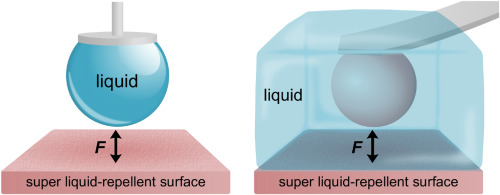Current Opinion in Colloid & Interface Science ( IF 7.9 ) Pub Date : 2019-12-10 , DOI: 10.1016/j.cocis.2019.11.012 Mimmi Eriksson , Agne Swerin

|
Forces exerted at surfaces and interphases due to formation of gaseous (air or vapor) bridges describe the extreme liquid-repellence in superhydro- and amphiphobicity. The neighboring research areas of liquid capillary bridges and that of interactions between hydrophobic surfaces are highly valuable reference systems. We review recent findings with particular focus on the three-phase contact line and surface forces. While macroscopic contact angles (>150°), low contact angle hysteresis (<10°, but can be high; parahydrophobic or petal type) and low roll-off angle (≤5-10°) are adequate criteria for superhydrophobicity (SH) and superamphiphobicity (SA) for most studies, a detailed understanding requires a view related to mechanisms. Experimental studies of liquid drop-substrate and particle-substrate adhesion in hydrophobic, SH and SA systems are summarized by relating measured forces to the wetting tension, . A low wetting tension value is a necessary but not sufficient criterion for SH and SA systems.
The picture emerging from detailed force-distance studies is that extreme liquid-repellence in SH and SA systems is a progression of liquid-repellence due to hydrophobicity, in which force curves can be explained by capillary forces of constant volume of the gaseous capillary. In SH and SA, neither the capillary force equation assuming constant volume, nor constant pressure, of the gaseous capillary explains experimental force measurements as the capillary increases in both volume and pressure. In recent experimental studies a transition is observed into non-constant volume and pressure which suggests a SH and SA wetting transition from constant volume or pressure to a capillary growth as driven by the and the works but also by forces at the three-phase contact line, viz. pinning forces, and , and line energy, , terms. Supported by calculations of the different contributions, we suggest this transition being an appropriate definition for the onset of (appreciable) superhydro- and amphiphobicity.
中文翻译:

超疏水和超疏水表面上的力
由于形成了气态(空气或蒸汽)桥而在表面和相间施加的力描述了超疏水和两亲性中的极端拒液性。周边研究领域液体毛细管桥以及疏水表面之间的相互作用的毛细管桥是非常有价值的参考系统。我们回顾了最近的发现,特别关注三相接触线和表面力。宏观接触角(> 150°),低接触角滞后(<10°,但可能很高;副疏水或花瓣型)和低滚降角(≤5-10°)是超疏水性(SH)的适当标准对于大多数研究,以及对超恐惧症(SA)的深入了解,需要对有关机理的看法。通过将测得的力与润湿张力相关联,总结了疏水性,SH和SA系统中液滴-基质和颗粒-基质粘附的实验研究,。对于SH和SA系统,较低的润湿张力值是必要但不充分的标准。
图片来自详细的ce-distance研究表明,SH和SA系统中的极端拒液性是由于疏水性导致的拒液性的发展在这种情况下,力曲线可以用恒定体积的气态毛细管的毛细管力来解释。在SH和SA中,当毛细管的体积和压力均增加时,无论是假定毛细管体积恒定还是恒定压力的毛细管力方程都无法解释实验力的测量结果。在最近的实验研究中,观察到过渡到非恒定的体积和压力,这表明SH和SA的润湿从恒定的体积或压力过渡到毛细血管的生长,这是由,和功以及由三相接触线施加的力驱动的。 ,即 钉扎力,以及和线能量 条款。在对不同贡献的计算的支持下,我们建议这种过渡是(明显)超疏水和两亲性发作的适当定义。











































 京公网安备 11010802027423号
京公网安备 11010802027423号